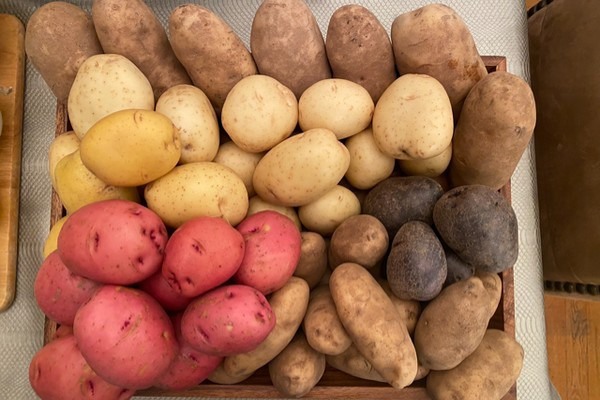There is a good high-quality supply of Russet and colored potatoes at the moment. "We have a highly marketable crop of potatoes in most areas," says Harris S. Cutler of Race-West Company, Inc. noting that its growing regions are Idaho, Washington, and Canada. "Our home shipping areas will have adequate supplies to get us deep into the early summer."
In all, it's more of a balanced picture than what has been seen in recent years–in 2023-2024, supply was on the more plentiful side, and in 2022-2023, supply was tighter. "We reached a point then where a carton for foodservice was $50-$60 and now it's $18-$20–it's a more reasonable price and the returns are adequate at the growing level."

In all, the supply of potatoes right now is more balanced than in recent years. In 2023-2024, supply was on the more plentiful side, and in 2022-2023, supply was tighter.
Matching supply and demand
Cutler in general would like to see a better meeting of production and demand and points to what is happening in pears right now as an example of the need to do so. "The U.S. is very short on pears There are pockets of international production that happen to be very long on pears. We have to get to a point where some of these abundances and shortages have to meet together better. The producers of vegetables have to get their production more in line with demand and retailers have to be encouraged to partner with farms so they can have reasonably priced product regularly," he says.
As for prices, at a time when consumers continue to struggle with food prices, Cutler says there is increased demand for vegetable staples such as potatoes but also onions, sweet potatoes, and carrots. "These items are reasonably priced and becoming more and more popular and more and more involved in people's diets. I'd say consumption of these items is on the way up," he says, adding that more flexibility from retailers on pricing would also help strengthen movement.
 Cutler says the producers of vegetables have to get their production more in line with demand and retailers have to be encouraged to partner with farms so they can have reasonably priced product regularly.
Cutler says the producers of vegetables have to get their production more in line with demand and retailers have to be encouraged to partner with farms so they can have reasonably priced product regularly.
Why demand is good
That said, the demand for potatoes is constant and strong. "Potatoes are at the same price people paid in the 70s, 80s, and 90s and it's amazing we're able to provide so much for a reasonable price," says Cutler. What's also helping the movement is the fact that the industry has also worked on developing better, more flavorful potatoes in varieties such as yellow potatoes, which are now more popular than white potatoes for example. Meanwhile, consumers are also continuing to learn how to prepare potatoes more healthfully.
Pricing that supports all parts of the supply chain can be done, he says, pointing at retail chain Aldi as one that's operating with an enviable business model. "They've gone from having the smallest of produce items so they could be at a reasonable price to having some of the best produce," Cutler says, noting that the chain is closely partnering with its grower suppliers to help do this. "I encourage other retailers to look at what they're doing because families need support now. There's not going to be a tremendous raise in wages and inflation seems to be slowly getting under control. However, if we have a way where we can actually give people healthy product as an industry, that starts with having product prices that are within a reasonable range. Potatoes and onions could teach a lesson to the rest of the commodities as to how to market themselves so that there's profit at the farm level, profit at the distribution level, and great prices for consumers."
 For more information:
For more information:
Harris S. Cutler
Race-West Company, Inc.
Tel: +1 (570) 586-5700
[email protected]
https://www.race-west.com/










